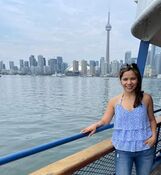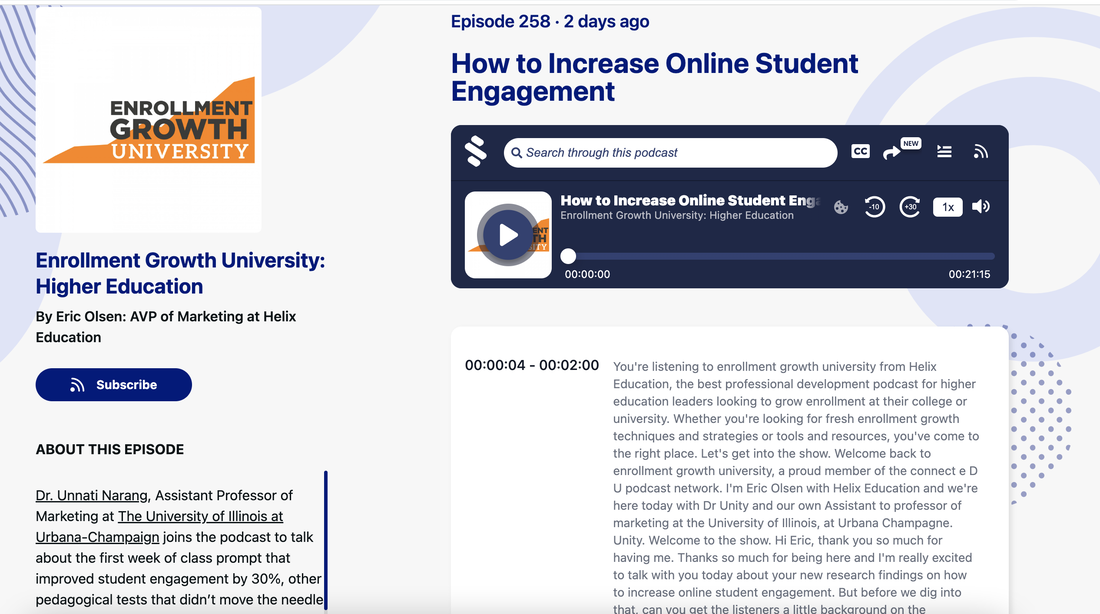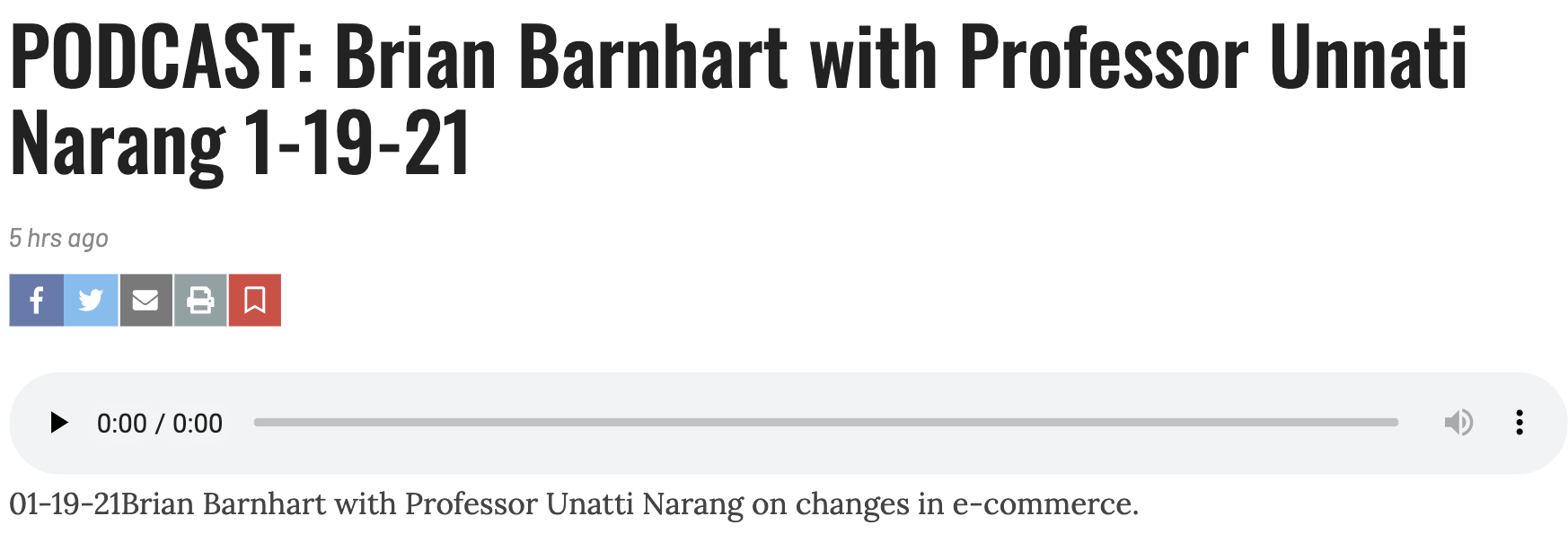|
0 Comments
 This post describes my recent research visit to the University of Toronto in June 2022. It's meant to serve as a potential guide for other junior faculty interested to plan a research visit (i.e., an ultra mini sabbatical, or ums). I cover topics, such as how I started thinking about ums, how I planned it, what helped me get the most out of it and how you can still have fun while working and traveling. I recently discovered that many junior faculty and students have found my blog and informal musings about academic life in #marketing useful. How did I discover this? At the virtual Marketing Science conference, I “ran into” (at the Gather Town virtual simulation) at least three PhD students from three different schools who said that they had read my blog (and my papers – whoa!) and that it helped them decide to pursue their PhD. One even said that I MUST continue writing these posts. In the spirit of believing that maybe I do have something useful to say, this post is dedicated to a recent experience I had: a short research visit to another university, i.e., University of Toronto, over the summer. I think of this visit as an ultra-mini sabbatical or ums, just like the filler word umm, symbolizing a pause, although a deliberate one. For those of you who don’t know me, I’m currently finishing my second year as an Assistant Professor of Marketing at the University of Illinois at Urbana-Champaign. This means that a fair bit of my dissertation research is wrapping up (hopefully) and that I’m on the cusp of something exciting i.e., developing new papers and crafting my research identity. All of this, while teaching three different courses including an online MBA course and MOOC on Applying Data Analytics in Marketing, mentoring PhD and Masters' students, and serving my profession, department, and school in various ways. So, what was I doing in Toronto? What prompted my visit? What were the pros and cons, and how did I make the most of it? Origin of my ums I first started thinking about ums when I saw a Twitter post by another assistant professor of marketing, saying he was going to spend some time in Italy visiting another school. Some universities have a structure and a more formal process for visiting scholars but for most, if you know someone there, perhaps a senior mentor, it could be worth exploring informally if the visit makes sense. The purpose of these visits can vary greatly depending on what you want out of them. You can meet and learn about various faculty in the department, get feedback on your papers, start new collaborations, and work on existing projects if you already have co-authors at that school. Since a full sabbatical is often not feasible or recommended for junior faculty, a mini sabbatical is a potential path that gives you more time compared with a typical 2-day visit for a research seminar but is shorter than a one-year commitment. I wanted to visit the Rotman School of Management at the University of Toronto for various reasons. First, I had visited them for a job talk during my academic job market year. They had seen my job market paper during my campus visit. In fact, the feedback I had received during my presentation and meetings there had already been super helpful on my earlier drafts. This is also the paper I’m currently revising and one that could benefit from immediate feedback before I sent it back to the journal. Second, they’d been very warm and receptive during my last visit, and I had since been in touch with several of the faculty there. One of their former PhD students is also my very good colleague and friend at the U of I and I also know her co-authors well. Third, I have overlapping research interests, both in methods and topics, with multiple faculty members in their marketing group. When I wrote to them exploring a potential visit, I also learned that most faculty I’d want to meet with was around in the summer. Finally, my cousin had serendipitously just moved from New Delhi to Toronto in May. So, I could also get to see her. Planning the ums The two big considerations for planning the ums are the visit timing and budget. The timing is important for both strategic and tactical reasons. Strategically, it makes sense to visit when you have projects at various stages in your pipeline. Depending on the faculty or PhD student you are meeting and the amount of time you have with them, it could help to have some advanced papers waiting revision, new working papers that are not yet submitted and a few new ideas you may be on the verge of starting or may have collected data for. Tactically, my visit was ideal during the summer. At least in 2022, summer is the only time I don’t teach (since I’ve borrowed my future Spring ‘23 teaching into Fall ‘22). This is also a summer when the global pandemic has subsided, and people are more available to meet in person. Depending on the school and department, it might also make sense to visit during your non-teaching semester if more faculty members are around at that time and/or you want to attend their regular seminar series, etc. Paperwork, such as getting a work permit in another country, may also influence the timing of visit. Finally, the timing should also make sense personally, especially if you have children and may have to visit with family. I have two dogs and a cat, and my husband was more than happy to watch them. His work is also only a five-minute commute from our home, so he could walk them during his lunch hours. The budget for the visit is another important consideration, particularly when visiting a major (and expensive!) city. Most schools can support accommodation and travel for a few days if you are giving a talk but will not be able to support longer stays. They might be able to offer an office or working space, access to the building, and Internet credentials. One way to fund an ums is to set aside some of your own research and travel/conference funds. You can also combine the trip with a conference in that area or close to the airport you’re flying from, if you don’t live near an airport. I was going to drive from Champaign to Chicago to present at the Advances with Field Experiments conference, so I planned my visit right after that. Chicago is also the nearest airport for me to fly to Toronto, so I flew from there directly. Another suggestion for keeping the visit affordable is to explore accommodation options on campus. I was able to stay at New College Residence at one sixth the cost of a hotel. Living close to the campus you’re visiting also allows you more flexibility (and less Ubers!). If you’re a gym-fanatic like me, there are also always free gym trials or short-term memberships available. Finally, if your accommodation provides a kitchen, consider traveling with basic cooking equipment. I packed a small pan with me and pretty much made myself an egg-white omlette every morning for breakfast. This is also healthier option, especially since you’ll likely end up getting several meals outside for lunch meetings, etc. During the ums I have a bunch of advice for what to do during the ums. First, make sure everyone (at least anyone you plan to meet) in the department knows you are visiting. You can do this by sending the faculty an email a week or more before you go. In my case, I had been in touch with at least two of the senior faculty there since April for my June visit. I was sharing my office with a junior faculty, who’d herself reached out to me a week before to let me know about being officemates. I’d also emailed most of the other faculty individually a week before the visit. In general, 90% of them said they’d be around and would love to meet. Instead of formally setting up doodle or something (who wants to deal with this super formally during a summer visit?! Of course, you can if that’s what you prefer), I started maintaining a google doc with my own itinerary and booking meeting times at my end. I wanted to make sure I wasn’t double-booked, that I didn’t miss any meetings, and that I was tracking meeting-related conversations across all possible conversation channels (e.g., two PhD students reached out to me on Twitter and Facebook to set up coffee chats). Second, make sure you plan ahead of the meetings. While ums is not a campus visit and you don’t need to read everyone’s entire set of research papers, it helps to know what they are doing and what their recent research projects are about. Why? In my experience and conversations, this helped me select the right projects from my pipeline to talk about and the right questions to ask. I learned, for example, that someone I was meeting for lunch had recently published a paper on giving incentives for COVID vaccines. While I don’t have a COVID-related project, I have a new project on financial- and non-financial incentives for going to the gym. It ended up being a meaningful conversation and he gave me several ideas for potential new experimental designs as well as literature to consult. Third, build in some deliberate pauses or gaps between meetings. If I had a meeting at 2pm, I’d not schedule my next one until 4pm. I don’t think I did this on purpose so much, but it worked great because sometimes we ended up going for a long-ish walk to talk, and I didn’t need to rush anyone for my next meeting. This is the kind of rush you’d typically experience in a 2-day research talk visit. In some of my longer meetings, the first half hour or so could be dedicated to a specific project or a warm-up conversation, so the real topics of connection or possibility of a collaboration would not even come up until much later. Having less time-pressured meetings was a great benefit of a longer visit! Fourth, don’t hesitate to reach out to someone and meet multiple times. There are no rules. Again, unlike a 2-day seminar visit, you can find opportunities for continuing your conversation. I met with a junior colleague who is at the same career stage as me once for a quick chat in the office, then for dinner (it happened to be my birthday that week, so we celebrated!), and then again over brunch. It wasn’t until the third conversation that we even explored any ideas about potentially working together. Similarly, a senior faculty member gave me some excellent feedback for my job market paper, so I was able to circle back and meet with him the following week to share what I was finding based on the analysis he had recommended and get detailed feedback on my overall research portfolio. In another case, a senior faculty member wanted to meet a second time to discuss my marketing analytics syllabus in detail. The opportunities for multiple meetings can be rich and rewarding for everyone. Finally, don’t overplan. LOTS of work and conversations can happen serendipitously. During my visit, I learned that someone else in quantitative marketing was also visiting Toronto. I’d talked to him virtually before. I reached out to him and was able to meet in person for a great conversation! Stuff Zoom can’t do justice to :) Work-life balance in ums Last but not the least, an important goal of ums is to reset. It can allow you to step out of your comfort zone and routine, and to try something different. Travel gives you a chance to step away from the structure of your daily life. Make sure to enjoy it. During the weekend and some of the evenings, for example, I explore Toronto Islands, the Little Italy food festival, and dinner with my cousin. Cheers to a dream summer, and to many of you, hopefully exploring your own ums after reading this!  Five years. 2015-2020. When I started my PhD five years ago, like any new incoming student experiencing the academic world for the first time, I had naive expectations about research and doctoral education. In this article, I share my own experience and challenge five myths new students often have about getting a PhD: 1) It is all about grand ideas. Grand ideas are a good start. However, execution of a few good ideas is what gets you through. When I started my PhD in Marketing, I had the grand vision of researching how the mobile-first world impacts consumers and firms in different domains, including retail (how we shop), education (how we learn), and healthcare (how we access health services). Many first year PhD students come in with a grand vision and think they must pursue it all. When defining the scope of my doctoral research, it helped to keep three things in mind:
2) The dissertation is the be-all-end-all of my PhD research and must have lasting impact on the field. There are differing perspectives and philosophies on what a dissertation is and should contain. I personally found it helpful to conceptualize my dissertation as a set of related papers that together fairly represent my broad interest areas, demonstrate my empirical skills, and introduce sufficiently new ideas or insights to an existing body of work. Often, PhD students get caught up in the "impact" trap -- where we want to create impactful research right away. Consequently, no manuscript or draft seems "good enough." The danger is a resulting research paralysis, a kind of a "writer's block" that prevents progress. Along my PhD journey, lots of people gave me good practical advice that helped get my first drafts done. Three senior academics at different times told me:
3) Unless I go to a top school or find a well-known advisor, it doesn't count. Incoming new students often place tremendous weight on top schools and popular advisors. While these factors can help, ultimately your peers, colleagues and recruiters are all looking for signals about YOU. Who are you independent of your advisor or school? What do you care about? Have you demonstrated research acumen, perseverance and initiative? Over the years, as I have seen PhD students who entered a PhD program only to find their advisor leave their job at the university or department management and budgets severely changed, this perspective may be a good reminder to take ownership of their projects despite all odds as they work to improve their circumstances. 4) Unless my advisor contributes, I cannot make progress. Let's face it. Advisors are busy. They are constantly juggling teaching, traveling, multiple projects, and sometimes, even consulting. Waiting for your advisor to do the work for you is dangerous even if they have the best of intentions. Do your part. Do as much as you can. Go out there and find the help you need -- online, offline, at the library. Most of the problems you are waiting on your advisor to solve for you may have been solved before. Take your best solution to your advisor instead of just the problem statement. You will be surprised how much faster things are able to move. 5) More number of manuscript will help me succeed. Advanced and finished projects with a fair pipeline are much better than a bunch of loosely connected works-in-progress or working papers. Prioritize prioritize prioritize. Yes, we all need some "fun" projects and starting new projects is always fun. As they age and get further along in the review process, projects tend to become drudgery for anyone. That's the time to push through. Instead of constantly starting new projects, finish the ones you start. Every research has weaknesses and the review process is geared to bring them up. Preempt them. Acknowledge them. Fix them to the extent possible. Turn those manuscripts back in. If you are going to get it rejected, might as well find out sooner than later. Finally, along the way, have fun! Make friends. Explore your campus. Reach out to people. Talk to people at conferences. Talk to people outside your field. Ask lots of questions. Help others. The journey is so much more memorable that way. Best!  Intense retail competition has led old standbys, such as Sears, to close dozens of stores. Walmart is venturing online more. And Amazon is expanding offline, opening stores and buying Whole Foods. The fight for retail dollars is fierce, and the battleground will soon migrate into the palms of customers’ hands – via apps on their smartphones. This isn’t just happening with mega-retailers. Movie chains and pet supply stores are increasingly connecting with their customers through their own branded apps. Zumiez, a specialty clothing chain with 600 stores in the U.S., has an app. Scooter’s Coffee, an Omaha-based coffee chain with 200 stores, has one too. So does New York Pizza Oven, a single pizza parlor in Vermont. Mobile apps are becoming key ways for customers and retailers to interact. Our recent analysis of data from a large U.S. retailer of video games and electronics (whose name we agreed to keep confidential) found that apps can even affect consumers’ offline buying habits. Growth in use – and spending The number of people who have the option to use mobile apps is skyrocketing. More than 70 percent of the world population will own a smartphone by 2020. And they’ll spend more than 80 percent of their on-phone time using task-specific apps. Is there no line because people are ordering ahead on their mobile phones? Letting buyers learn about products, discover deals, locate nearby stores and even place orders in advance is a huge business opportunity. At Starbucks, for example, an app allowing people to order and pay on the go – just swinging into the store for pickup – helped customers avoid standing in line and waiting: Over five years, 20 percent of its sales shifted to online transactions. Research has also begun to show that people who use mobile shopping apps buy more than they might otherwise. After individual shoppers started purchasing using eBay’s mobile app, their purchases from eBay’s website increased. Similarly, a tablet app from major Chinese e-tailer Alibaba led customers to spend about US$923.5 million more each yearwith the company than they would have without the app. Some of that increased spending is from shoppers using the app to buy impulsively – making one-off purchases of items they are interested in, or adding items to larger orders. Our research recently found a new dimension to this app-related spending boost. Over 18 months, customers who downloaded the branded app of the retailer we studied spent 30 percent more in stores than they would have without the app. We can infer this by looking at data on customers’ spending before and after the app was installed, and by comparing that to the spending of a random sample of customers who had similar demographics and shopping behavior before the app launched. We learned that most of the increase was because customers used the app to find out about products before buying them. For example, by closely analyzing the data on app use and purchases, we could see these customers started increasing purchases of lesser known video games when they started using the app. App users return products more While shoppers who use a retailer’s mobile app tend to buy more online and in stores, we find that they are also more prone to subsequently returning the products they purchased. In particular, customers who use a retailer’s app tend to return products most often when they purchased those products on discount, and within seven days of making the original purchase. Apps often make it easier to purchase items on impulse. When customers receive some of the items and are dissatisfied, they regret the decisions and return the items. Even taking into account the high rate of returns, app users spend more both online and in physical stores. But that’s when the apps work as customers expect them to. App failures –- and consequences Apps that load information slowly or crash frequently can deter not only online purchasing, but in-person spending, too. Surveys show that more than 60 percent of users expect an app to load within four seconds. And our ongoing research suggests that more than half of users will abandon an app that freezes or crashes frequently. App slowdowns can be costly. One estimate suggests that if each Amazon webpage took just one second longer to load, the company’s sales could drop as much as $1.6 billion a year. For smaller retailers, a similar drop of 2 to 3 percent would be a smaller dollar amount but still a significant blow. Our ongoing research with Stanford’s Sridhar Narayanan suggests that poor app performance reduces users’ in-store spending too. Specifically, we studied how shoppers react when an app is not accessible for five or six hours, due (users were told) to a server error. Our preliminary results suggest that in the following two weeks, those shoppers spent 3 to 4 percent less in stores than they would have otherwise. Less-frequent customers reduced their spending even more than the company’s more regular shoppers. Unnati Narang discusses her ongoing research on failures in mobile shopping apps.Interestingly, customers who experience app failures spend less in stores, but their online spending remains unchanged. A deeper analysis indicates that when a retailer’s app fails, shoppers often go to the retailer’s website to complete their intended transactions. But the negative experience from app failure discourages them from buying more in the retailer’s store. Our research illustrates some ways mobile apps can be a double-edged sword for customers and retailers alike. Shoppers can use apps to learn more about prospective purchases, be inspired on the fly and save time at the cash register. But if the software fails, they may be frustrated, discouraged and even spend less at physical stores. Retailers can see increased sales and faster transactions, but may have to handle more returns – though they’ll still make more money. The longer-term effects of mobile apps on the retail business have yet to be seen, of course, but in an ever-changing landscape, companies and customers alike will be exploring the options. (written with Dr. Venkatesh Shankar, Mays Business School; originally published on ConversationUS) Do mobile apps influence shopper purchases and product returns? We model the effects of app adoption in the context of a large omnichannel retailer with 32 million shoppers. We leverage the launch of a mobile app by the retailer and use a difference-in-differences approach to identify and estimate the differences between app adopters and non-adopters in shopping outcomes, such as the incidence and monetary value of purchases and product returns. We find that app adopters buy 21% more often but spend 12% less per purchase occasion and return 73% more often than non-adopters in the month after adoption. Overall, app adoption results in a 24% increase in net monetary value of purchases. Our findings are robust to alternative explanations and measures. Furthermore, our analysis of the drivers of app use reveals that exposure to offers and rewards through the app plays a key role in driving shopping outcomes. Surprisingly, the number of unique app features accessed by the shopper has an inverted U-shaped relationship with shopping outcomes, suggesting managerial caution against “all-in-one” app designs.
Keywords: difference-in-differences, exponential Type II Tobit, mobile marketing, mobile apps, quasi-experiments Download paper here. |
DISCOVERExciting marketing research, cutting-edge methods, and highlights from marketing conferences Categories
All
Archives
May 2024
|


